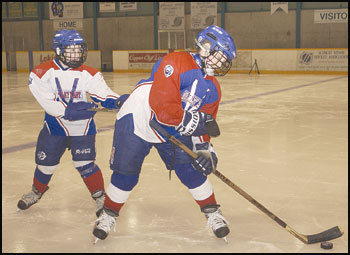 From
the view that you, the fan saw, it looked like Jamie was being hooked and
from that view it looks like a no brainer. Therefore, of course a minor penalty
should be called for ‘Hooking’ against Darcy. It is very obvious and
if the Referee viewed the play from the same place you were
seated maybe a penalty
would be called. From a game management point of view, by calling a
hooking penalty against Darcy at this point in the game would probably
help to alleviate the imbalance of penalties on the score sheet and quiet
down the crowd.
From
the view that you, the fan saw, it looked like Jamie was being hooked and
from that view it looks like a no brainer. Therefore, of course a minor penalty
should be called for ‘Hooking’ against Darcy. It is very obvious and
if the Referee viewed the play from the same place you were
seated maybe a penalty
would be called. From a game management point of view, by calling a
hooking penalty against Darcy at this point in the game would probably
help to alleviate the imbalance of penalties on the score sheet and quiet
down the crowd.
However, as a referee you must remember
that by creating a power play it is likely that the Blue team will score
(as they are the stronger team) and this may change the entire momentum of
the game in favor of the Blue team. The Blue team may end up tying the
game afterwards with the momentum on their side and they even might win
the game. But hey, we can’t tell the future so we must call what we see.
From the vantage point of the original photo you would call a hooking penalty against the white
player and that would be it.
But Wait a minute!
The referee has blown the
play dead and called penalties to both players!
He called a penalty against the Blue player, Jamie, for ‘Holding
the Stick’ and against the white player, Darcy, for ‘Hooking’.
You
are stunned and can’t believe your eyes. However, in the picture that
you see above (the exact view that the Referee had on the play) you
can see that even though Darcy did put his stick up under Jamie’s arm,
which he shouldn’t have done, Darcy was not trying to hook Jamie, he was
merely trying to get his stick back from Jamie who was holding onto the
stick in an attempt to draw a penalty and get his team on the power play.
Why would the Referee call a penalty on
both players?
Perhaps the referee wanted to communicate to both teams that
Darcy did place a little hook (that would normally not be called) but
Jamie was also guilty of holding Darcy’s stick and therefore by
assessing both players a penalty at this point in the game, both the
coaches and the fans may realize what just happened and it will in essence
keep the game "under control".
Furthermore, by assessing both
players penalties, no team will receive a power play for something that
normally would not have been called.
Other options for the referee would be to
not even call a penalty, but then the fans and coaches (who had the
vantage point of the original photo which showed what the view behind the
play) would be upset because no hooking
call was made.
He could have called a penalty on Blue for
‘Holding the Stick’ but this call would not be too popular with the
locals and especially not the Blue team’s coaching staff as they have
already received the majority of the penalties in the game. Especially a
non-impact penalty such as ‘Holding The Stick’ this late in the game.
It likely would have resulted in the coach being ejected for over-reacting
and the game would end in a terrible battle.
He could have called a penalty on White for
‘Hooking’ and no coaches or fans would be upset because from their
vantage point it looked like an obvious hook. The only one in the whole
arena who saw the holding the stick was the referee. However, the referee must
call what he sees and not what he thinks the coaches or fans see,
regardless of the possible reaction.
This example gives a good lesson about how
a referee may see something completely different from what what the fans or coaches
see. It
does not mean that anyone is wrong by making the call they thought should
be made. It is just that the referee’s vantage point is all that counts
in the final decision and he only has a split-second to factor in all of
the above scenarios.
